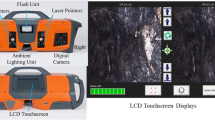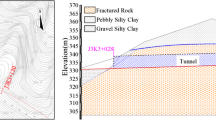Abstract
The strength, deformation characteristics and failure mechanism of tunnel surrounding rock are affected by the rock mass discontinuity. In order to explore the influence of the existence of rock mass discontinuity on the mechanical parameters and the instability mechanism of surrounding rock mass, the 3D digital photogrammetry system is used to measure the rock mass of Guangshan No. 1 tunnel to obtain the geometric information of discontinuities and its probability distribution model. Based on the information of rock mass discontinuity obtained by digital photography technology, the volumetric joint count (Jv) and joint roughness coefficient (JRC) are introduced to quantitatively study the geological strength index (GSI), and Hoek–Brown strength criterion is used to analyze the mechanical parameters of tunnel rock mass. According to the strength parameters of tunnel rock mass, the numerical simulation of excavation stability of the tunnel is carried out. The research results show that 3D digital photography can accurately locate the joints exposed by rock excavation in tunnel site, and the quantitative GSI method can accurately determine the rock strength parameters in Hoek–Brown strength criterion, which is conducive to the accurate simulation analysis of tunnel surrounding rock stability. The research realizes the digital identification of information of jointed rock mass, quantitative analysis of rock mass mechanical parameters and numerical simulation of tunnel stability, which provides a fast and practical method for stability analysis of tunnel with joint development.















Similar content being viewed by others
Data Availability
The data used to support the findings of this study are included within the article.
References
Bertuzzi R, Douglas K, Mostyn G (2016) Comparison of quantified and chart GSI for four rock masses. Eng Geol 202:24–35
Fathipour-Azar H (2021) Data-driven estimation of joint roughness coefficient. J Rock Mech Geotech Eng 13(6):1428–1437
García-Luna R, Senent S, Jurado-Pia R, Jimenez R (2019) Structure from Motion photogrammetry to characterize underground rock masses: experiences from two real tunnels. Tunn Undergr Space Technol 83:262–273
Hoek E, Brown ET (1997) Practical estimates of rock mass strength. Int J Rock Mech Min Sci 34(8):1165–1186
Hong K, Han E, Kang K (2017) Determination of geological strength index of jointed rock mass based on image processing. J Rock Mech Geotech Eng 9(4):702–708
Hou D, Yang X (2018) Physical modeling of displacement and failure monitoring of underground roadway in horizontal strata. Adv Civ Eng 9:1–11
Hou DG, Fu X, Lu CM (2021a) Research on failure process and precursor information of surrounding rock of deep layered roadway based on digital image correlation method. Geotech Geol Eng 39:4817–4831
Hou DG, Zheng XY, Xu F (2021b) Study on monitoring technology of surrounding rock in deep layered roadway based on constant resistance and large deformation bolt. Geotech Geol Eng 39:3903–3916
Hu GJ, Yang TH, Shi WH, Yu QL, Liu HL, Wang PT, Wang SH (2014) Digital recognition and key block identification of rock mass structure in Anjialing Coal Mine. J China Coal Soc 39(12):2412–2417
Kang K, Fomenko I, Nikolskaya OV, Wang J (2020) Probabilistic assessment of rock slope stability in open pit mine chaarat using the generalized Hoek–Brown criterion. J Min Sci 56(5):732–740
Karrech A, Dong X, Elchalakani M, Basarir H, Shahin MA, Regenauer-lieb K (2022) Limit analysis for the seismic stability of three-dimensional rock slopes using the generalized Hoek–Brown criterion. Int J Min Sci Technol 32(2):237–245
Keshavarz A, Kumar J (2018) Bearing capacity of foundations on rock mass using the method of characteristics. Int J Numer Anal Meth Geomech 42(3):542–557
Lang ZOU (2013) Estimation of mountain highway tunnel surrounding rock mechanics. Highw Eng 38(2):170–173
Li S, Liu H, Li L, Shi S, Hu J (2017) A quantitative method for rock structure at working faces of tunnel based on digital images and its application. Chin J Rock Mech Eng 36(1):1–9
Li S, Liu H, Li L, Shi S, Sun S (2018) State and trends of dangerous rock prevention and control during tunnel construction. China J Highw Transp 31(10):5–22
Li H, Guo T, Nan Y, Han B (2021) A simplified three-dimensional extension of Hoek–Brown strength criterion. J Rock Mech Geotech Eng 13(3):568–578
Lina GE, Fu YI, Tao WANG (2020) Structural plane information characterization and application based on digital photogrammetry. Chinese J Comput Mech 37(5):103–109
Liu L, Wang Y, Wang J, Wang Z (2015) Fluid-driven fractures in granular materials. Bull Eng Geol Env 74:621–636
Liu X, Han G, Wang E, Wang S, Nawnit K (2018) “Multiscale hierarchical analysis of rock mass and prediction of its mechanical and hydraulic properties.” J Rock Mech Geotech Eng 10(4):694–702
Marsch k, Fernandez Steeger TM (2021) Comparative evaluation of statistical and fractal approaches for JRC calculation based on a large dataset of natural rock traces. Rock Mech Rock Eng 54(4):1897–1917
Palmstrom A (2005) Measurements of and correlations between block size and rock quality designation (RQD). Tunn Undergr Space Technol 20:362–377
Qiaoyun H, Yi Z (2019) Kongqing L and Zou Shenghua, “Computational evaluation of cooling system under deep hot and humid coal mine in China: a thermal comfort study.” Tunn Undergr Space Technol 90:394–403
Reece K (2020) Gabriel and Walton, “A case study on the efficacy of different roof bolting schemes in Lhoist North America’s Crab Orchard Mine.” Int J Min Sci Technol 3(1):96–101
Shengming HU, Xiuwen HU (2011) Estimation of rock mass parameters based on quantitative GSI system and Hoek–Brown criterion. Rock Soil Mech 32(3):861–866
Somodi G (2018) gnes Krupa, L Kovács and B Vásárhelyi, “Comparison of different calculation methods of Geological Strength Index (GSI) in a specific underground construction site.” Eng Geol 243:50–58
Sun G, Gaojian HU, Xiao P, Wang X (2017) Study on strength calculation and quality grading of slope rock in Fushan West Open Pit Mine. Coal Sci Technol 45(12):36–42
Tajduś K (2010) Determination of approximate value of a GSI Index for the disturbed rock mass layers in the area of Polish coal mines. Arch Min Sci 55(4):879–890
Wang K, Dongqiang XU (2016) Application of quantitative GSI in the estimation of rock mechanics parameters. J Railw Sci Eng 13(11):2168–2173
Wang Y, Wang SH, Guo MD, Dong ZH (2011) Fast digital identification of joint information of tunnel work face and its stability analysis. Chinese J Geotech Eng 33(11):1734–1734
Wang C, Elsworth D, Fang Yi, Zhang F (2020) Influence of fracture roughness on shear strength, slip stability and permeability: A mechanistic analysis by three-dimensional digital rock modeling. J Rock Mech Geotech Eng 12(4):720–731
Xia K, Chen C, Liu X, Zheng Y, Zhou Y (2013) Estimation of rock mass mechanical parameters based on ultrasonic velocity of rock mass and Hoek–Brown criterion and its application to engineering. Chin J Rock Mech Eng 32(7):1458–1466
Xing J, Guo Z, Yujie LI, Qiu J, Sun X (2019) Calculation of mechanical parameters of fractured rock mass based on fuzzy clustering and Hoek–Brown criterion. China Min Mag 28(5):140–145
Xua J, Yang X (2018) Seismic stability analysis and charts of a 3D rock slope in Hoek–Brown media. Int J Rock Mech Min Sci 112:64–76
Yong R, Ye J, Liang QF, Huang M, Du SG (2018) Estimation of the joint roughness coefficient (JRC) of rock joints by vector similarity measures. Bull Eng Geol Env 77(2):735–749
Zareifard MR, Shekari MR (2021) Comprehensive solutions for underwater tunnels in rock masses with different GSI values considering blast-induced damage zone and seepage forces. Appl Math Model 96(1):236–268
Zhang Y, Liu X, Li X, Wang S, Ren F (2019) Numerical characterization for rock mass integrating GSI/Hoek–Brown system and synthetic rock mass method. J Struct Geol 126:318–329
Zhao X, Liu J, Zhang H, You W, Liu F (2014) Rockmass structural plane digital recognition and stope stability classification based on the photographic surveying method. J Min Saf Eng 31(1):127–133
Zheng C, Yang TH, Liu HL, Liu QL, Liu TL (2011) Slope rock mass structure digital photogrammetry and research on mechanical parameter in Dagushan Iron Mine. J China Coal Soc 36(3):383–387
Zhou J, Yang XA (2021) An analysis of the support loads on composite lining of deep-buried tunnels based on the Hoek–Brown strength criterion. Tunn Undergr Space Technol 118:104174
Zou X, Wang C, Han Z, Wang J, Wang Y, Song H (2017) Fully automatic identifying the structural planes with panoramic images of boreholes. Chin J Rock Mech Eng 36(8):1910–1920
Acknowledgements
Financial support from the Central Guidance on Local Science and Technology Development Fund of Hebei Province under grant No. 226Z1201G and the Young Fund of Scientific and Technological Research Projects of Higher Education Institutions in Hebei Province under grant No. QN2019183 and Foundation of Hebei Province for Selected Overseas Scholar under grant No. C20210109 and Project for Young Top Talents of Langfang City under grant No. LFBJ202008 and Ph. D Foundation Project of North China Institute of Aerospace Engineering under grant No.BKY-2018-21 are gratefully acknowledged.
Author information
Authors and Affiliations
Contributions
DH, the overall idea of the paper and the paper writing. XZ, the numerical simulation. YZ, analysis of on-site monitoring data. CG, the numerical simulation. CW, the experimental data analysis.
Corresponding author
Ethics declarations
Conflict of Interest
The authors declare that there is no conflict of interests regarding the publication of this paper.
Additional information
Publisher's Note
Springer Nature remains neutral with regard to jurisdictional claims in published maps and institutional affiliations.
Rights and permissions
Springer Nature or its licensor holds exclusive rights to this article under a publishing agreement with the author(s) or other rightsholder(s); author self-archiving of the accepted manuscript version of this article is solely governed by the terms of such publishing agreement and applicable law.
About this article
Cite this article
Hou, D., Zheng, X., Zhou, Y. et al. Analysis and Application of Surrounding Rock Mechanical Parameters of Jointed Rock Tunnel Based on Digital Photography. Geotech Geol Eng 41, 721–739 (2023). https://doi.org/10.1007/s10706-022-02298-0
Received:
Accepted:
Published:
Issue Date:
DOI: https://doi.org/10.1007/s10706-022-02298-0




